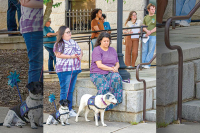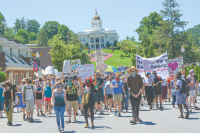Weavers bring finest of craft to WNC
By Julia Merchant • Staff Writer
This April, nearly 100 professional weavers and spinners will converge at Lake Junaluska in Haywood County for the Southeast Fiber Forum.
They’ll come to share their knowledge and learn new crafts — “everything from broom making to surface design to knitting to weaving to basketry,” says Marjorie Warren, board chair of the Western North Carolina Handweavers Guild and also chair of the Fiber Forum.
Attendees are members of the Southeast Fiber Forum Association, a group of 877 weavers hailing from Texas all the way to Virginia.
This year’s theme of the Forum is based on the United Nation’s declaration of 2009 as “Year of Natural Fiber.” The focus at the forum is on fibers that are natural and sustainable such as wool, linen, bamboo, cotton and flax — essentially, anything that isn’t synthetic.
“There is a great awareness this year, with everything going ‘green,’ of being environmentally conscious and using what is available to us,” Warren said.
Related Items
Western North Carolina’s abundance of natural resources makes it a fitting location for the conference, with its focus on all things natural. The region is also fitting due to its long tradition of weaving, dating back thousands of years to the Cherokee who first wove baskets out of the bark of the rivercane plant. Today, many weavers still make a living from their craft, practicing it in all different forms. WNC weavers will teach classes at the Forum to weavers from around the country.
“We’re so fortunate in this area that we have so many wonderful teachers that we don’t have to fly everybody in,” said Warren. “This is a chance to showcase the teachers in our area.”
Two of the presenters from the region represent the diversity of the craft in Western North Carolina. Kathie Roig, a weaver who owns KMR Handwovens in Dillsboro, uses a complicated Swedish loom to weave her creations, which include functional items like placemats, scarves, tote bags and baby bibs. Roig uses sustainable materials like cotton to form her pieces. She also works with tencel, a unique material made out of wood pulp that drapes and feels like silk.
“It’s produced relatively environmentally friendly,” said Roig. “How you get yarn from things can be harmful for the environment, but tencel is relatively not.”
Roig, who teaches weaving at the prestigious John C. Campbell School of Folk Art in Brasstown, says WNC has a rare concentration of weavers in a small region.
“What I see is a stronger focus on having your craft really support you,” Roig said. “There’s many more folks here that are supporting themselves from their work and being successful at it.”
Beth Johnson, a weaver in Cherokee, emphasizes the use of natural fibers of many different kinds. Johnson works with the Revitalization of Traditional Cherokee Artisan Resources, which works to preserve the materials that Cherokees have used for thousands of years to make their crafts. At the moment, Johnson is working with some local bison ranches to obtain fiber from the animals. Cherokee at one time wove the bison fiber with their fingers instead of on a loom, making for very intricate pieces.
Johnson is also researching plants the Cherokee used to weave, including hemp and mulberry bushes.
At the Forum, Johnson is teaching a workshop that teaches a sustainable form of weaving similar to recycling. This form originated in Japan, and employs old kimonos cut into strips and woven into a lightweight fabric. Johnson makes scarves and bags with this method.
“Nearly all weaving traditions all over the world have some way of recycling stuff, whether through patchwork quilting or weaving rag rugs,” Johnson says.
The work of Johnson, Roig and other weavers who will be teaching at the Fiber Forum is on display at Gallery 86 in downtown Waynesville through Saturday, April 25. The public is also invited to check out the display of vendors and crafts at the Fiber Forum all day Saturday, April 18, at Lake Junaluska.









